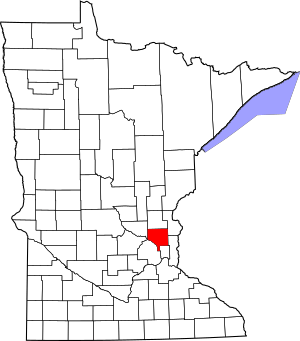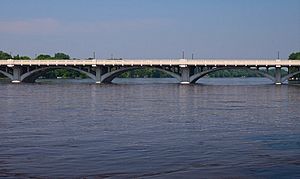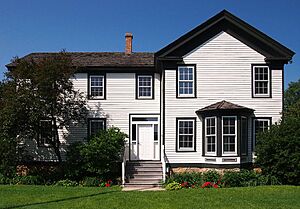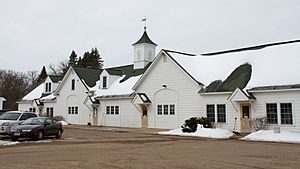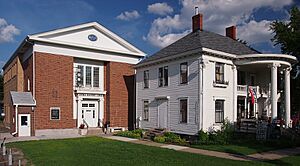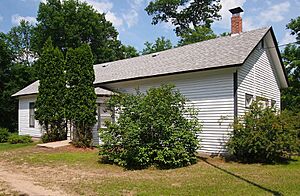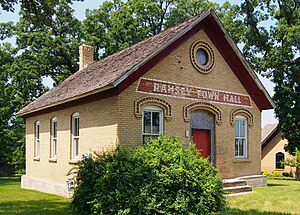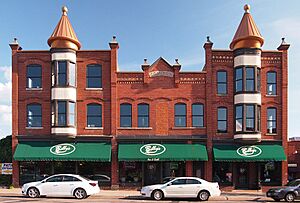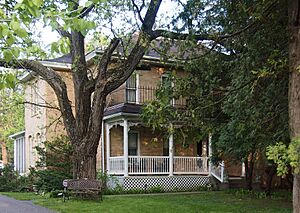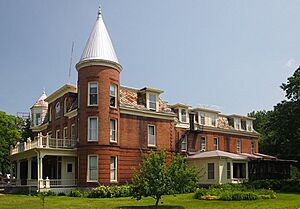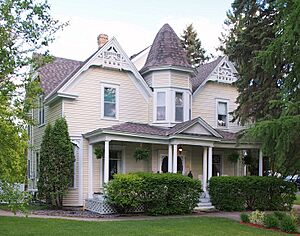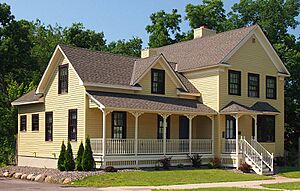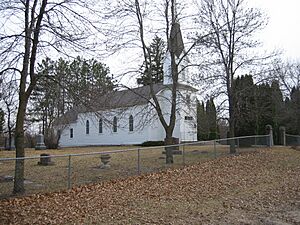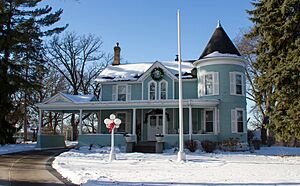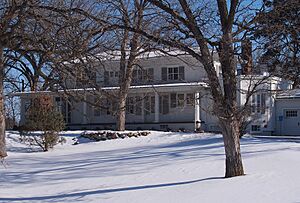National Register of Historic Places listings in Anoka County, Minnesota facts for kids
This page lists special places in Anoka County, Minnesota, that are part of the National Register of Historic Places. Think of it like a national list of important buildings, bridges, and areas that tell a story about history. These places are protected because they are valuable parts of America's past.
There are 18 historic places in Anoka County on this list. There was also one other place that used to be on the list but isn't anymore.
Contents
- Historic Places in Anoka County
- Anoka Post Office
- Anoka-Champlin Mississippi River Bridge
- Banfill Tavern
- Carlos Avery Game Farm
- Colonial Hall and Masonic Lodge No. 30
- Crescent Grange Hall No. 512
- District No. 28 School
- Jackson Hotel
- Porter Kelsey House
- Kline Sanatarium
- H. G. Leathers House
- Riverside Hotel
- Shaw-Hammons House
- Sparre Barn
- Swedish Evangelical Lutheran Church
- Heman L. Ticknor House
- Windego Park Auditorium/Open Air Theater
- Woodbury House
- Former Listing
Historic Places in Anoka County
Anoka Post Office
Built in 1916, the Anoka Post Office is a beautiful old building. It's designed in a style called Georgian Revival architecture, which means it looks a bit like grand old homes from the 1700s. This post office is the oldest public building still standing in Anoka. It's also considered the most important non-home building in the city because of its design.
Anoka-Champlin Mississippi River Bridge
This bridge was built in 1929 and crosses the Mississippi River. It's a great example of a special type of concrete bridge called an "open-spandrel arch bridge." Many bridges like this were built near the Twin Cities in the late 1920s. This bridge was also very important because it connected the two towns of Anoka and Champlin across the river. Part of this bridge is also in Hennepin County.
Banfill Tavern
The Banfill Tavern is one of the oldest and best-kept wooden houses in Anoka County. It was built way back in 1847. The house is designed in the Greek Revival architecture style, which was popular in the mid-1800s. Today, this historic building is known as the Banfill-Locke Center for the Arts. It's a place where people can enjoy and learn about art.
Carlos Avery Game Farm
The Carlos Avery Game Farm was once one of the most important places in the country for raising game animals. It was also one of Minnesota's first big projects to manage wildlife. Many of its buildings were constructed between 1936 and 1938. The farm is also special because its buildings use a style called Colonial Revival architecture, which is unusual for a game farm.
Colonial Hall and Masonic Lodge No. 30
This building started as the home and office of Dr. Alanson and Flora Aldrich in 1904. They were a doctor couple who were very important leaders in Anoka. After they passed away, the building was made bigger in 1922 to include a Masonic Temple. It's also known as the best-preserved example of a Georgian Revival architecture house in Anoka, designed by Frederick Marsh.
Crescent Grange Hall No. 512
This building is an early example of a "Grange" hall in Minnesota. Granges were groups for farmers that helped them work together and support each other. The Crescent Grange Hall was built between 1881 and 1882. It's located west of Martin Lake near East Bethel.
District No. 28 School
This old schoolhouse was built in 1892. It's a one-room school, which was common back then. Its construction shows how many public buildings were being built in rural Anoka County in the late 1800s. It's also one of the few brick buildings from that time in the county. Later, this building became the Ramsey Town Hall.
Jackson Hotel
The Jackson Hotel was a very important hotel that operated from 1884 to 1975. It reminds us of how Anoka rebuilt itself after a big fire in 1884. It also shows Anoka's role as a busy trading center back then.
Porter Kelsey House
This house was built in 1887 by a brick company owner. It's important because it shows the history of brickmaking in Anoka County. It's also a well-preserved old country home from the 1800s, with features of Italianate architecture.
Kline Sanatarium
The Kline Sanatarium was Anoka's first hospital, open from 1902 to 1935. It was a big symbol of Anoka's early reputation for being a healthy place with excellent medical care.
H. G. Leathers House
This house was built around 1883 and later moved and made bigger around 1890. It's connected to three generations of a very important local family. It's also one of the few Victorian architecture style houses left in Anoka County.
Riverside Hotel
The Riverside Hotel is the only old commercial building left from when St. Francis was a busy lumber town. It started as a house around 1860 and was later expanded to offer lodging for lumber and mill workers. Today, it's known as the Rum River Inn restaurant.
Shaw-Hammons House
This house was built in 1852 and made bigger in 1870. It's linked to the early settlement of the area through its important first owners. It's also the best-preserved example of Greek Revival architecture in Anoka.
Sparre Barn
The Sparre Barn is a very well-preserved example of a round barn. It was built between 1917 and 1924. It also represents the dairy farms of Anoka County and the barn designs of local architect Ernest Marsh.
Swedish Evangelical Lutheran Church
This church, built in 1872, is very well-preserved. It shows the strong Swedish American heritage of the largest group of immigrants who settled in Anoka County.
Heman L. Ticknor House
This house is connected to three generations of an important local family. It also shows three different architectural styles! It has an older Gothic Revival architecture part from 1867, and then a fancy update from 1901 in the Queen Anne and Neoclassical architecture styles. Today, it's a bed and breakfast.
Windego Park Auditorium/Open Air Theater
These are the remains of an open-air theater built in 1914. It was unique in Minnesota and was part of a project to make cities more beautiful. It was a place for local events until 1938. It used to have a colorful canvas roof designed by famous architects Purcell & Elmslie, but that is no longer there.
Woodbury House
The Woodbury House tells the story of Anoka's very first years. It's linked to Dwight Woodbury, who helped develop the town. The original part of the house, built in 1857, shows the Federal architecture and Greek Revival architecture styles. Today, it's known as The Mad Hatter Restaurant & Tea Room.
Former Listing
This section lists a place that was once on the National Register of Historic Places but has since been removed.
Richardson Barn
The Richardson Barn was a log barn built around 1870. It was used to store hay and showed what early buildings in Anoka County were like. It also represented hay as a very important crop in the area from the 1860s to the 1940s. Sadly, this barn was taken down in the late 1990s, so it is no longer on the list.


